
Leopold I was the first king of the Belgians, reigning from 21 July 1831 until his death in 1865.

Princess Charlotte Augusta of Wales was the only child of George, Prince of Wales, and his wife, Caroline of Brunswick. She was expected to ascend the British throne after the deaths of her grandfather, George III, and her father, but died in childbirth at the age of 21, predeceasing them both.

Augusta of Reuss-Ebersdorf, was by marriage the Duchess of Saxe-Coburg-Saalfeld. She was the maternal grandmother of Queen Victoria and the paternal grandmother of Albert, Prince Consort.

Ernest I was the last sovereign duke of Saxe-Coburg-Saalfeld and, from 1826, the first sovereign duke of Saxe-Coburg and Gotha. He was the father of Albert, Prince Consort, who was the husband of Queen Victoria. Ernest fought against Napoleon Bonaparte, and through construction projects and the establishment of a court theatre, he left a strong imprint on his residence town, Coburg.
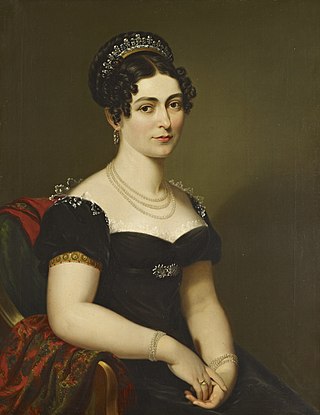
Princess Victoria of Saxe-Coburg-Saalfeld, later Princess of Leiningen and subsequently Duchess of Kent and Strathearn, was a German princess and the mother of Queen Victoria of the United Kingdom. As the widow of Charles, Prince of Leiningen (1763–1814), from 1814, she served as regent of the Principality during the minority of her son from her first marriage, Carl, until her second wedding in 1818 to Prince Edward, fourth son of George III.
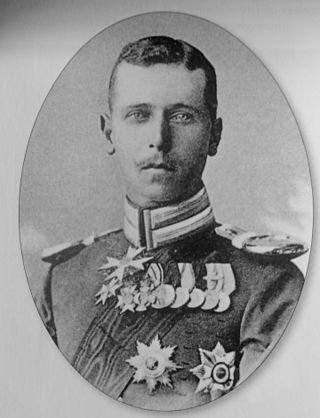
Alfred, Hereditary Prince of Saxe-Coburg and Gotha, KG,, was the son and heir apparent of Alfred, Duke of Saxe-Coburg and Gotha. He died aged 24 under circumstances still not entirely clear. He was a first cousin of Kaiser Wilhelm II of Germany, King George V of the United Kingdom and Tsar Nicholas II of Russia.
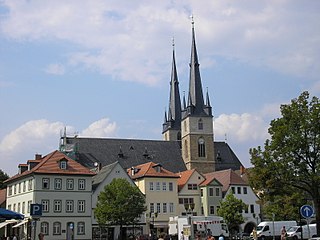
Saalfeld is a town in Germany, capital of the Saalfeld-Rudolstadt district of Thuringia. It is best known internationally as the ancestral seat of the Saxe-Coburg and Gotha branch of the Saxon House of Wettin.

Coburg is a town located on the Itz river in the Upper Franconia region of Bavaria, Germany. Long part of one of the Thuringian states of the Wettin line, it joined Bavaria by popular vote only in 1920. Until the revolution of 1918, it was one of the capitals of the Duchy of Saxe-Coburg and Gotha and the Duchy of Saxe-Coburg-Saalfeld.
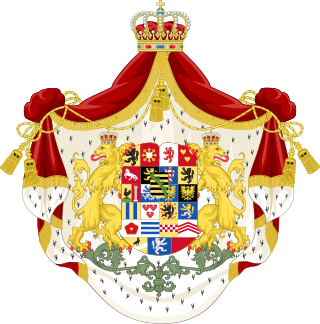
The House of Saxe-Coburg and Gotha is a European royal house. It takes its name from its oldest domain, the Ernestine duchy of Saxe-Coburg and Gotha, and its members later sat on the thrones of Belgium, Bulgaria, Portugal, and the United Kingdom and its dominions.
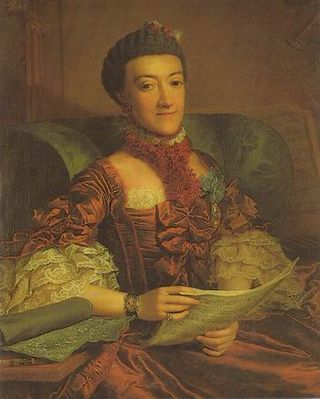
Princess Charlotte Sophie of Saxe-Coburg-Saalfeld, Duchess in Saxony was a German duchess.

Princess Anna Sophie of Schwarzburg-Rudolstadt was a Princess of Schwarzburg-Rudolstadt.

Princess Frederica of Hanover was a member of the House of Hanover. After her marriage, she lived mostly in England, where she was a prominent member of society.
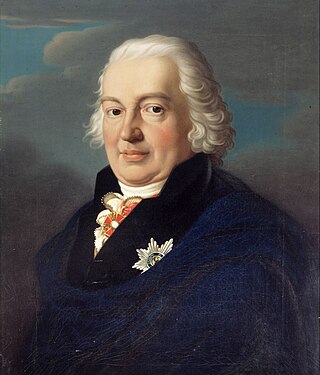
Francis, Duke of Saxe-Coburg-Saalfeld, was one of the ruling Thuringian dukes of the House of Wettin. As progenitor of a line of Coburg princes who, in the 19th and 20th centuries, ascended the thrones of several European realms, he is a patrilineal ancestor of the royal houses of Belgium and Bulgaria, as well as of several queens consort and empress consort of Mexico in the 1860’s.

Prince Ferdinand Georg August of Saxe-Coburg and Gotha was a German prince of the House of Saxe-Coburg and Gotha and a general of cavalry in the Austrian Imperial and Royal Army during the Napoleonic Wars. Initially remaining a Lutheran until 1818, by marriage he established the Catholic branch of the family, which eventually gained the thrones of Portugal (1837) and Bulgaria (1887).

August Victor Louis of Saxe-Coburg and Gotha, was a German prince of the Catholic House of Saxe-Coburg and Gotha-Koháry. He was a General Major in the Royal Saxon Army and the owner of Čábráď and Štiavnica, both in modern-day Slovakia.
The Royal Palace of Brussels is the official palace of the King and Queen of the Belgians in the centre of the nation's capital, Brussels. However, it is not used as a royal residence, as the king and his family live in the Royal Palace of Laeken in northern Brussels. The website of the Belgian Monarchy describes the function of the Royal Palace as follows:
The Royal Palace is where His Majesty the King exercises his prerogatives as Head of State, grants audiences and deals with affairs of state. Apart from the offices of the King and the Queen, the Royal Palace houses the services of the Grand Marshal of the Court, the King's Head of Cabinet, the Head of the King's Military Household and the Intendant of the King's Civil List. The Royal Palace also includes the State Rooms where large receptions are held, as well as the apartments provided for foreign Heads of State during official visits.

St George's Chapel at Windsor Castle in England is a castle chapel built in the late-medieval Perpendicular Gothic style. It is a Royal Peculiar, and the Chapel of the Order of the Garter. St George's Chapel was founded in the 14th century by King Edward III and extensively enlarged in the late 15th century. It is located in the Lower Ward of the castle.

On 6 July 1893, Prince George, Duke of York, and Princess Victoria Mary of Teck were married at the Chapel Royal, St. James's Palace, in London, England.
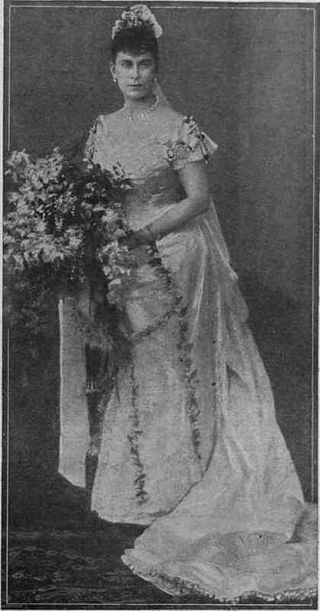
The wedding dress of Princess Victoria Mary of Teck is the gown worn by the future Queen Mary at her wedding to Prince George, Duke of York on 6 July 1893 at the Chapel Royal, St. James's Palace, in London. The dress now belongs to the British Royal Collection and is part of a collection of royal wedding dresses at Kensington Palace in London.

The wedding dress of Princess Maud of Wales was worn at her wedding to Prince Carl of Denmark on 22 July 1896 in the Private Chapel at Buckingham Palace. Maud was the youngest daughter of Albert Edward, Prince of Wales and Alexandra, Princess of Wales; Carl was the second son of Crown Prince Frederick and Crown Princess Louise of Denmark.



















